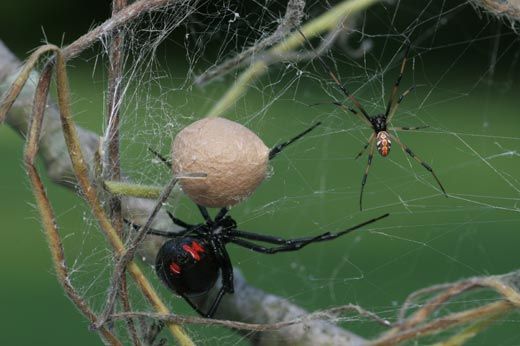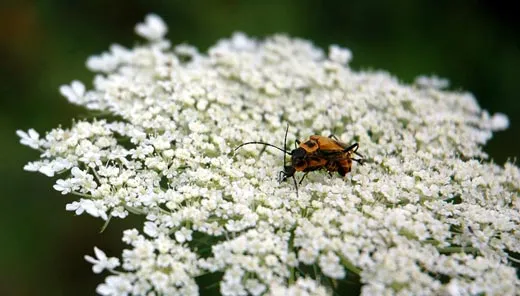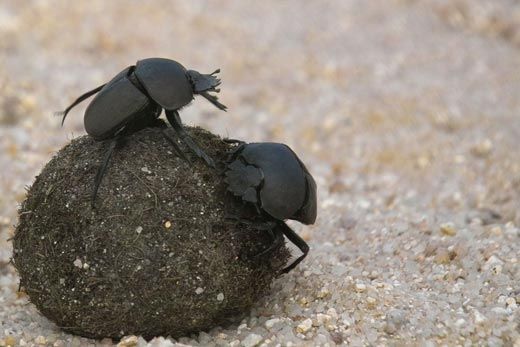The Curious Do’s and Don’ts of Insect Dating Behavior
Bugs tap, dance and buzz to attract their mates—and some get eaten
/https://tf-cmsv2-smithsonianmag-media.s3.amazonaws.com/filer/lightning-bugs-mating-631.jpg)
This Valentine’s Day, thank the stars not just for your sweetie but also for the creepy-crawlies that help furnish the holiday’s staples. Those dozen roses are luscious and red in order to attract pollinating insects, says Tom Turpin, an entomologist at Purdue University. Cacao trees -- whose seeds ultimately wind up in a gazillion heart-shaped boxes -- also rely on insects for reproduction, and your beloved’s silky negligee is courtesy of the silkworm. Reproduction looms large in the short and frantic lives of these tiny creatures, and the insect mating scene may sound familiar to some humans. There’s fierce competition (queen bees are sometimes pursued by buzzing “comets” of suitors), blatant cuckoldry (female water bugs will glue their eggs to the wings of males who are not their mates) and all-consuming passion (females of many species eat their mates). And inevitably, there are males behaving badly: A recent study of fruit flies exposed to alcohol, for instance, showed that inebriated males attempt to mate with most anything that moves and eventually wind up chasing each other in a circle.
Whole tomes have been devoted to the mysteries of bug love – see James Wangberg’s Six-Legged Sex: The Erotic Lives of Insects, for starters – but here are ten peculiar, kinky, and sometimes downright romantic examples:
10) Knock Three Times
The male tarantula is most polite, tapping his legs gently at the entrance of a female’s burrow to lure her out. It isn’t quite throwing pebbles at her window, but close enough…
9) Forget Godiva
Male hang flies, which hang on the undersides of leaves to copulate, entice females with a captured prey insect. “The term is a ‘nuptial gift,’” says Zack Lemann, visitor programs manager at the Audubon Insectarium. “Females need to assess the fitness of the male, and seeing he’s good at catching prey is one way to do that.” And males like to know they won’t get eaten in the act.
8) Harmonizzzzzzing
The same species of mosquito that transmits diseases like yellow fever can also carry a tune, and individual skeeters adjust their buzz frequencies to perform sophisticated duets with their mates.
7) Like a Moth to a Perfume?
The male giant silk moth is drawn irresistibly to the female’s pheromones and can pick up a single molecule of her scent more than a mile downwind.
6) Flashers
Lighthouses of love, male fireflies drift around flashing patterns to females below, who flash responses of their own. Alas, one female firefly fly, known as the “femme fatale” of the insect world, mimics the patterns of other species and draws the males down to her. “They are expecting a mate but she turns them into a meal,” Turpin says.
5) Try A Little Tenderness
Some forms of springtails caress each other with their antennae before mating. John Lubbock, the 19th century entomologist, described their “attentive” courtship: “It is very amusing to see these little creatures coquetting together…moving backwards and forwards like two playful lambs.” At one point in the courtship, the female pretends to flee; the males charges after her. “Then she turns coyly around…then for a bit they stand face to face….and seem to be all in all to one another.”
4) Wings of Love
Colonies of red imported fire ants produce “winged reproductives,” flying ants that don’t forage or care for larvae and pupae but exist only to breed. “They’re kind of a lot like teenagers,” writes Bart Drees, a professor of entomology at Texas A&M University. “They just hang around the colony for weeks or months, consume a lot of food and wait until it’s ‘party time:’ the first sunny day after a rainy period. When they leave the nest, they fly high up into the air and mate.” But reality soon sets in: the male dies not long after the midair tryst.
3) Atmosphere Is Everything
Dung beetles get frisky exactly where you’d expect them to – in heaps of manure. Sometimes pairs also work together to roll a “brood ball” of dung and soil that serves as a nursery for their young.
2) Termighty Love
King and queen termites are the only ones in a colony that reproduce, but, as Rebeccah Waterworth, an entomology graduate student at the University of California Riverside, says, “the pair is monogamous and mates for life.” Some queens can live for a decade, so they even have a shot at a tenth anniversary. Tradition calls for tin or aluminum gifts, but perhaps they’d prefer wood?
1) Love Bites
Female spiders, which tend to be bigger than males, are notorious for snacking on their partners, which is why male black widows sometimes wrap up their mates up in silk beforehand. (Occasionally, Lemann says, a strapping female will “bust out of the silk and grab her mate and eat him” anyway.) But in the Australian black widow’s mating ritual, “post-copulatory suicide” is routine. The male “does a sort of somersault into her fangs,” Lemann says; his body nourishes her as she makes their eggs. Sweet.


